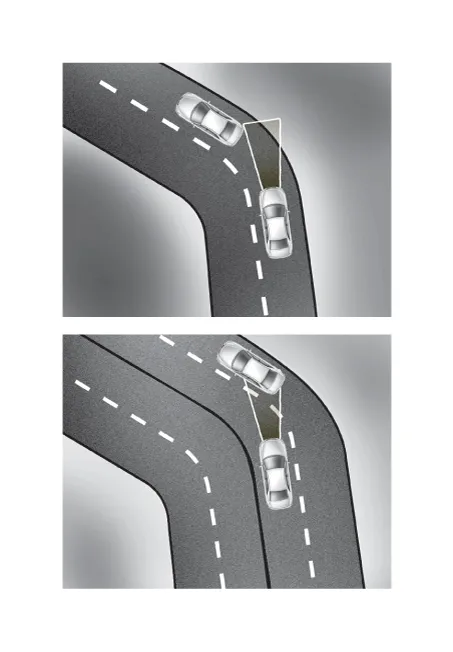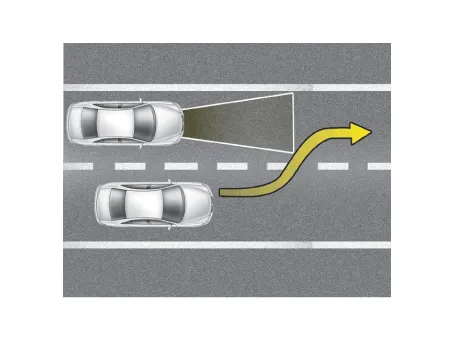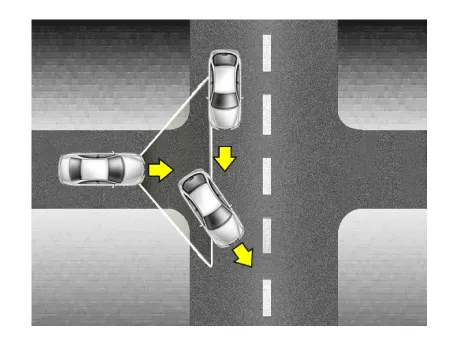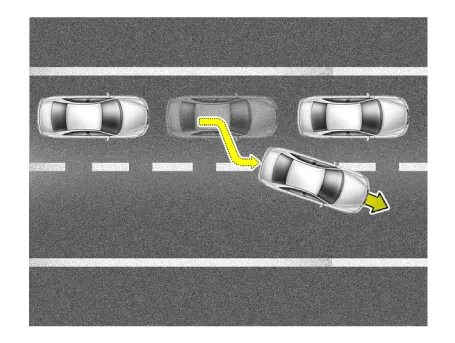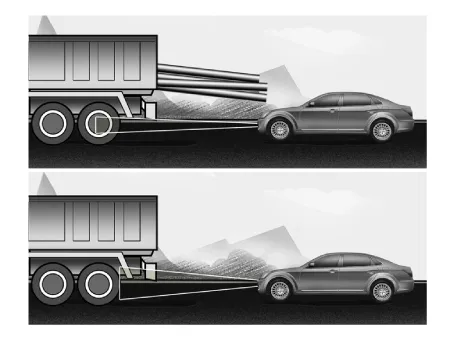Hyundai Elantra (CN7): Front Radar System / General safety information and caution
| General Safety Information and Caution |
| 1. | Be careful when driving the vehicle using the smart cruise control system as follows.
|
| 2. | In this following situation, the front vehicle can’t be recognized correctly so control the vehicle speed by applying the brake pedal or accelerator pedal if necessary.
|
| 3. | If the smart cruise control is left on (CRUISE indicator light ON), the smart cruise control can be switched on accidentally. Keep the smart cruise control system off (CRUISE indicator light OFF) when the smart cruise control is not in use, to avoid inadvertently setting a speed. |
| 4. | Observe a regulation speed on road when setting the cruise speed. |
| 5. | Use the smart cruise control system only when traveling on open highways in good weather. Do not use the smart cruise control when it may not be safe to keep the car at a constant speed, for instance, driving in heavy or varying traffic, or on slippery (rainy, icy or snow-covered) or winding roads or over 6% up-hill or down-hill roads. |
| 6. | Pay particular attention to the driving conditions whenever using the smart cruise control system. |
| 7. | The vehicle cannot be stopped by using the smart cruise control system. If emergency stop is necessary, you should apply the brakes. |
| 8. | Keep the safety distance according to road conditions and vehicle speed. If the following distance is too close at a high speed driving, it is dangerous. |
| 9. | The smart cruise control system can not recognize a stopped vehicle, pedestrians or an oncoming vehicle. Always look ahead cautiously to prevent unexpected and sudden situations from occurring. |
| 10. | The smart cruise control system is not a substitute for safe driving practices but a supplementary function only. It is the responsibility of the driver to always check the speed and the distance to the vehicle ahead. |
| 11. | In front of you, vehicles moving with a frequent lane change may cause a delay in the system's reaction or may cause the system to react to a vehicle actually in adjacent lane. Always look ahead cautiously to prevent unexpected and sudden situations from occurring. |
| 12. | Your vehicle may accelerate when a vehicle ahead of you disappears. When you are warned that the vehicle ahead of you is not detected, drive with caution.
|
| 13. | When vehicles are at a standstill and the vehicle in front of you changes to the next lane, be careful when your vehicle starts to move because it may not recognize the stopped vehicle in front of you.
|
| 14. | Always look out for pedestrians when your vehicle is maintaining a distance with the vehicle ahead.
|
| 15. | Always be cautious for vehicles with higher height or vehicles carrying loads that sticks out to the back of the vehicle.
|
Description and operation The System may be limited when • The radar sensor or camera is blocked with a foreign object or debris.
Other information:
Hyundai Elantra (CN7) 2021-2025 Service Manual: Head Lamp Leveling Switch
Schematic diagrams Schematic Diagrams Repair procedures Replacement1.Disconnect the negative (-) battery terminal.2.Remove the crash pad lower panel (A).(Refer to Body - "Crash Pad Lower Panel")3.Loosen the mounting screw and remove the crash pad lower switch (A).
Hyundai Elantra (CN7) 2021-2025 Service Manual: Troubleshooting
Trouble Symptom ChartsTrouble Symptom 1Trouble Symptom 2 Trouble symptom Probable cause Remedy The set vehicle speed varies greatly upward or downward"Surging" (repeated alternating acceleration and deceleration) occurs after settingMalfunction of the vehicle speed se
Categories
- Manuals Home
- Hyundai Elantra Owners Manual
- Hyundai Elantra Service Manual
- Driving your vehicle
- Interior Overview
- Tires and Wheels
- New on site
- Most important about car


